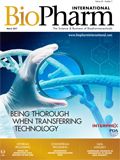Speed Bumps on the Road
The author discusses the results from TraceLink and Actionable Research's Global Drug Supply, Safety and Traceability Report.
In December 2016, TraceLink and the market research firm Actionable Research released results of the first Global Drug Supply, Safety and Traceability Report (1). The study surveyed 331 professionals from pharmaceutical manufacturers, wholesalers, pharmacies, and hospital pharmacies, to better understand issues and compliance trends at the lot level to get a more realistic picture of gaps in readiness, and the challenges that face pharmaceutical companies, distributors, and dispensers of all sizes in realizing full product traceability.
Half of the pharmaceutical companies that responded to the survey expect to comply with electronic data transfer requirements within six months of the November 2017 deadline, and 54% describe themselves as well-prepared for serialization. However, 19% of companies say they have not begun to address requirement, and only 24% say that their contract manufacturing organization (CMO) partners will be ready.
Respondents from pharmaceutical companies said that they underestimated the complexity of implementation, the total cost of IT upgrades required, and the overall impact that implementation can have on business. Customers at the dispenser level complain that the documentation needed for compliance is often missing from products that they buy directly from manufacturers. In their dealings with drug distributors, dispensers fear that their electronic data, which are now accessible via distributor portals, may not be available if they change distributors.
The following highlights from the research emphasize the data integration challenges inherent in serialization:
Roughly 37% of pharmaceutical companies bought a solution specifically designed to help with lot-level compliance, while 33% modified an existing third-party business system, 28% have implemented a manual process, and 20% have developed customized solutions.
- Twelve percent of T3s (data required for serialization, which include transaction statements and history as well as product information, e.g., lot number) are being handled via a portal, 30% on paper, and 58% electronically. Seventy-one percent say that customers cannot handle electronic transaction types, but 21% say that they are not prepared to handle them.
- In cases where pharmaceutical manufacturers sell directly to dispensers, 27% of respondents from retail pharmacies and 5% of respondents from hospitals say that they do not receive any compliance documentation when they purchase directly from the manufacturer.
- Eighty-three percent of pharma company respondents say they understand the Drug Supply Chain Security Act requirements, 70% say they can handle the scale and volume of data, and 67% say that responsibilities for serialization have been made clear within their companies.
- Where companies say they are not fully meeting requirements, 50% describe needing more dedicated resources, while 40% are concerned about customer connectivity.
- Fifty-four percent of pharmaceutical companies found that they had to modify systems to accommodate a customer request, but 16% reported being unable to make those changes.
- Twenty-six percent of pharmaceutical companies experienced an increase in bad or incorrect data exceptions as a result of the requirements.
Clearly, serialization challenges remain, but at least more companies “know that they don’t know,” and are networking and learning from their peers from pilot tests and implementations to figure out what to do next.
Reference
1. Systech, 2016 Global Drug Supply, Safety, and Traceability Report, tracelink.com, December 2016.
Article Details
BioPharm International
Vol. 30, No. 3
March 2017
Pages: 39
Citation
When referring to this article, please cite it as A. Shanley, "Speed Bumps on the Road" sidebar to "Serialization Hits the Home Stretch," BioPharm International 30 (3) p. 39, 2017.
